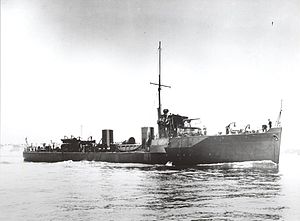 HMS Eden, an early River-class destroyer, was unusual in being driven by steam turbines.
| |
| Class overview | |
|---|---|
| Name | River or E class |
| Operators | |
| Preceded by | |
| Succeeded by | Tribal or F class |
| Built | 1903–1905 |
| In commission | 1903–1920 |
| Completed | 36 |
| Lost | 8 |
| General characteristics | |
| Type | Destroyer |
| Displacement | 535 long tons (544 t) to 570 long tons (580 t)[1] |
| Length | 221 ft (67 m) to 233 ft (71 m) (overall)[1] |
| Beam | 23 ft 6 in (7.16 m) to 23 ft 10.5 in (7.277 m)[1] |
| Draught | 7 ft 1 in (2.16 m)to 8 ft 0.5 in (2.451 m)[1] |
| Propulsion |
|
| Speed | 25.5 knots (29.3 mph; 47.2 km/h)[1] |
| Range | 1,620 nmi (3,000 km) to 1,870 nmi (3,460 km) at 11 kn, except Stour and Test, 3,000 nmi (5,556 km) at 13 kn.[1] |
| Complement | 70[1] |
| Armament |
|
The River-class destroyer (re-designated in 1913 as the E class) was a class of torpedo boat destroyer built for the Royal Navy in the first few years of the 20th century, and which saw extensive service in World War I. These 37 vessels (33 formally ordered under three annual construction programmes, plus another three built on speculation and then purchased by the Admiralty, and a final unit building in Italy for the Portuguese Navy and purchased in 1915) were all constructed to disparate builders' designs, just like the preceding classes.
The class introduced new features to destroyer design, placing a greater emphasis on seakeeping and endurance and less on a high maximum speed in good weather. All the ships were named after British, Irish and Portuguese rivers, and as such were the first Royal Navy destroyer class to be named systematically.